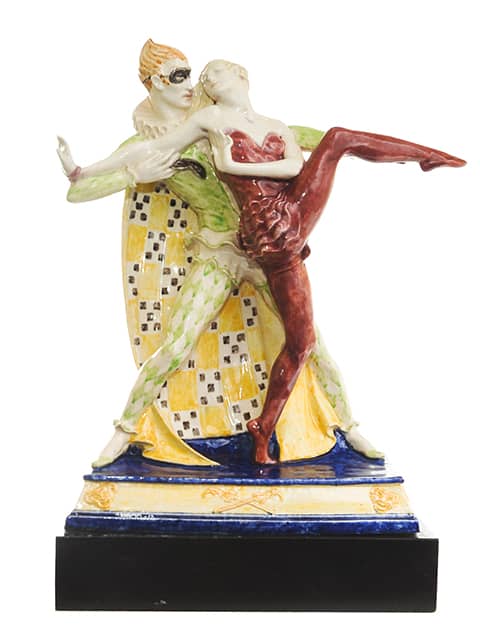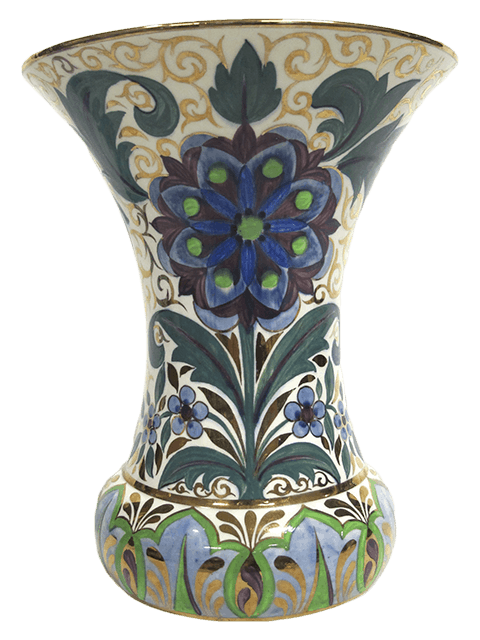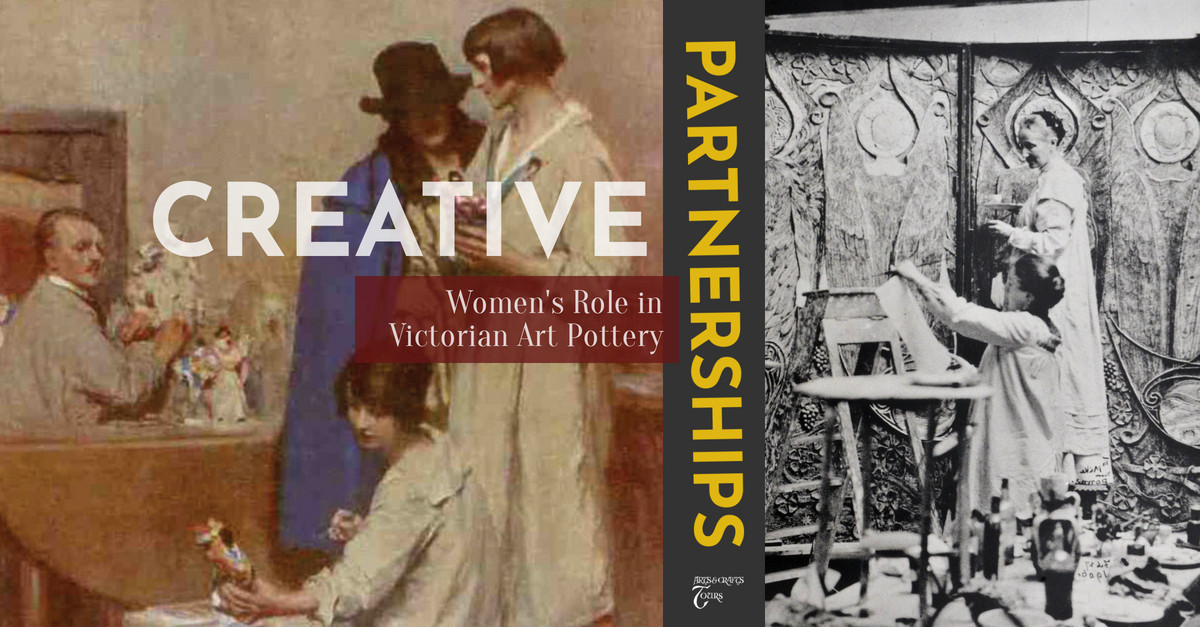In the late 19th century, more than 300 women found gainful employment at Doulton’s Lambeth art pottery in London. However, Henry Doulton believed that the “true sphere of woman is the family and household….” and his artists had to put down their paintbrushes when they married. Only occasionally did women continue to paint pottery for Doulton after marriage. Notable creative couples were Catherine Sparkes, the wife of the principal of the Lambeth School of Art, and Ada Dennis, wife of Walter Gandy, one of Doulton’s design managers.

William Morris, the Arts & Crafts design reformer, encouraged creative partnerships with his female friends and family members when establishing his decorating company at 8 Red Lion Square, London. For example, Edward Burne Jones hand-painted wall tiles with the assistance of Kate and Lucy Faulkner, the sisters of the firm’s accountant. Embroidered wall hangings were executed by needlewomen in the Morris circle, including Mary de Morgan, sister of the potter William de Morgan, and Morris’ daughter May, who later managed the textile business. A staunch campaigner for women’s rights, May Morris established the Women’s Guild of Arts in 1907 because membership of the Guild of Handicraft and the Art Workers Guild was closed to women.
Women also founded the Home Arts and Industries Association in 1885 to provide educational classes in art production and build appreciation for the beauty of traditional handicrafts through annual exhibitions. One of the pioneering members was the Scottish designer and potter, Mary Tytler, who married the symbolist painter George Frederick Watts in 1886. The couple moved to Compton, near Guildford, where Mary was the catalyst for the Watts Mortuary Chapel. Mary’s goal to create employment for rural communities was rooted in her belief that everyone could express themselves creatively through crafts. She trained workers to model the local clay for the execution of the chapel in a striking Celtic Revival style, which led to the establishment of the Compton Potter’s Guild in 1899. The Guild produced terracotta garden ornaments, including ornamental pots, sundials, and birdbaths, which were sold by Liberty’s of London. Compton pottery was favored by Gertrude Jekyll, the garden designer, and on her recommendation, they made miniature garden pots for Queen Mary`s dolls house, now at Windsor Castle.

Garden ornaments were also a specialty of Phoebe Stabler, who worked alongside her husband Harold in Upper Mall, Hammersmith in London. Phoebe attended art school in Liverpool and moved to London to study at the Royal College of Art. She married Harold, a stone carver, metalworker, and art teacher in 1906. Phoebe modeled glazed pottery figures, which initially she fired in her own kiln, but soon many of her designs were produced under license by leading manufacturers. She must have been a shrewd businesswoman because the same deigns were produced by Royal Doulton, Royal Worcester and the Poole Pottery. After World War One, Harold and Phoebe joined forces as Carter, Stabler and Adams at the Poole Pottery and collaborated on monumental ceramic sculptures for war memorials at Rugby School and the Durban Cenotaph in South Africa. Phoebe also revived figurative designs for the Ashstead Potters, founded in 1923 by Sir Lawrence Weaver to employ ex-servicemen in Surrey.
In the post-war years, it was much more affordable to cast sculptures in clay than in bronze and ceramic figures were very popular. Charles and Nell Vyse became famous for their figures of street vendors, gypsies, and circus folk. Charles had been apprenticed to Royal Doulton in Staffordshire and had modeled the first figures in their HN series, which was launched in 1913. After his marriage to Nell, the couple rented their own studio in Cheyne Row, London where Charles did the figure modeling and kiln firing while Nell did the painting and glaze research. She also added the flowers, which were formed petal by petal. Eventually, they hired female assistants and Nell juggled her role as a mother with her keen interest in socialist politics. Conversations on life and art were lively among fellow potters and prospective buyers at their ‘ceramic parties’ in their Chelsea studio.

Chelsea was the location of the first major English porcelain factory in the 18th century and several potters established studios in the vicinity. Miss Gwendolen Parnell achieved international recognition when she sold one of her first figures to Queen Mary in 1916. She held annual exhibitions at her Chelsea Cheyne Pottery and her dainty portraits of contemporary actors and dancers were highly regarded. In a 1925 interview she claimed, “To be a good potter, one must be an efficient cook, an excellent dressmaker, and an artistic designer, have a vast knowledge of chemistry, and be something of a navvy to undertake the waging of clay.” Miss Parrnell’s success inspired other women to make pottery figures. Nearby, Ethel Sleigh and Phyllis Simpson set up the Old Cheyne Pottery. Jessamine S. Bray and Sybil V. Williams made unique figures at the Dulwich Pottery and also designed for Royal Worcester. Joyce Bidder and Daisy Borne shared a studio in Wimbledon.
Another creative couple, Louise and Alfred Powell, influenced pottery design in London and Stoke-on-Trent through their association with the Wedgwood factory. Louise was the granddaughter of the esteemed Wedgwood freehand painter, Emile Lessore, and she used her skills in calligraphy and illumination to establish a decorating studio at 20 Red Lion Square, sponsored by Wedgwood in 1907. Louise and Alfred developed a new range of hand-painted Wedgwood art wares, inspired by 18th century designs, and taught a new generation how to paint on pottery at the Wedgwood factory. Their mantra was “Good Workmanship with Happy Thought.”
For the latest information on hours of operation, exhibitions, events, collections and more, visit the official of WMODA – Wiener Museum of Decorative Arts website at www.wmoda.com


